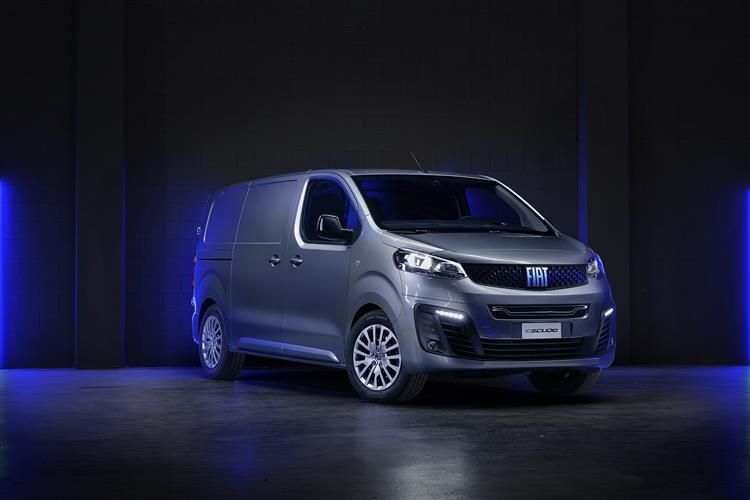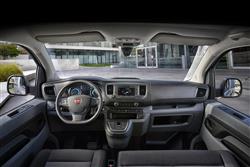SCUD-U-LIKE? (some text hidden) --NONE--
By Jonathan Crouch
Introductionword count: 72
You might not have been planning on your business's next mid-sized van being a Fiat. But this third generation Scudo model, thanks to borrowed Stellantis Group engineering and technology, might just be good enough to change your mind. Like its design stablemates, it's easy to live with, practical, efficient and nice to drive. It was a step forward then, for Fiat. Here, we look at earlier 2022-2024-era versions of the MK3 model.
Modelsword count: 5
Medium-sized van (1.5, 2.0 diesel/Full-Electric)
Historyword count: 287
Fiat. A brand as Italian as a Cornetto or Pavarotti - even when it comes to vans. But maybe not this one, the mid-sized Scudo, launched here in this MK3 form in 2022. It shared its design with a host of global manufacturers. Oh and did we mention the combustion versions were built in Britain? They were the first Fiat models ever to be so. That didn't apply to all versions of this MK3 Scudo. The EV variant, the all-electric E-Scudo, was made at the French Stellantis Group factory at Hordain, where all the conglomerate's mid-sized electric vans were fabricated. In this period. But the combustion-engined diesel Scudos most UK businesses wanted were indeed screwed together in Blighty, at the old Vauxhall factory in Luton. Between 2016 and 2021, the Italian marque's offering in this segment was called the Talento and shared all its engineering with comparable Renault and Nissan LCVs. But the launch of this replacement model in 2022 saw a return to a chassis shared with comparable Peugeot and Citroen van models, just as it was on the previous occasion that Fiat used the 'Scudo' badge for this class of LCV - for two generations of models sold between 2007 and 2016. By 2022, this Fiat shared engineering with comparable designs from Vauxhall and Toyota too. A benefit of this shared Stellantis Group platform was that it gave Fiat the opportunity to sell an all-electric version, an engineering package that by 2022 was already well proven by competing sister brand models. And the finishing touch to what seemed to be quite a complete offering in the mid-size segment. This LCV was updated in Spring 2024, but it's the pre-facelift 2022-2024-era Scudo we concentrate on here.
What You Getword count: 756
Does it really matter what a van looks like as long as the styling's smart and modern? Possibly not. Back in 2020, Fiat didn't waste too much time changing the front end of this one: just the usual corporate nose and bodywork, designed to blend in well with whatever your company's colours are. Your main advertising billboard space of course, is at the side and there's the option of getting more of it by opting for graduate up from the 'Standard'-length 4.95-metre L1 model to the 5.3-metre-long 'Maxi' L2 version. Unfortunately, either way there's only a single 1.9-metre roof height available. As usual in this class, as well as the panel van body style, there's the option of a Crew Cab version with a second seating row; and a Platform Cab variant for chassis conversions. Inside the cab, you'll find a very car-like cabin with the usual two-person passenger bench seat. You're not seated especially high by LCV standards and all-round visibility could be better, but getting comfortable is fairly easy, thanks to plenty of seat height and wheel adjustment, plus the provision of a left hand armrest. In addition, as you'd want, the cab is littered with different storage solutions, 49-litres of stowage capacity available in all. There's a centre 7-inch infotainment touchscreen and a further little display that appears between the instrument cluster's two analogue dials, the right hand gauge being either a rev counter or a Power Meter, depending on the drivetrain you've chosen. Top Scudo variants get a useful 'Moduwork' package, offering the facility to fold down the middle seat backrest and use this Fiat as a mobile office. There's an elasticated strap to secure your paperwork and, if you pull on the left hand side of the backrest top, you'll find that it swivels round into an ideal position for a laptop or a tablet, so that you can stop between deliveries to check up on your emails. The 'Moduwork' feature also includes stowage space below the centre seat; and a hatch through which long items from the cargo bay can be pushed into the cab. What about the cargo area? The standard 'L1' body shape offers a 5.3m3 cargo capacity and 2,512mm of floor length. Go for the lengthier 'L2' body style and you're looking at 6.1m3 and 2,862mm of floor length. The height from floor to ceiling is set at 1,397mm for all variants, which is 10mm more than the old standard-height Talento model could offer, explaining the slight improvement in cubic capacity figures with this MK3 Scudo. Another stat that all Scudo models share is the 1,628mm load area width, which narrows to 1,258mm between the wheel arches. Don't make your decision between these two body shapes until you've taken into account the potential extra capacity that can be freed up by the optional 'Moduwork' load-through bulkhead, should your chosen Scudo have it. Whichever body style you choose, this can add a useful 1,162mm to the overall loading length and 0.5m3 to the overall carriage capacity You'll need to know about payloads, which of course will vary according to your choice of engine, body style and, most significantly, Gross Vehicle Weight, which starts from 2695kg for the 1.5 diesel, it's from 3,100kg for the 2.0-litre diesel and from 3,025kgs for the E-Scudo. There's a broad spread of payloads. The base 1.5-litre models can take only 1,109kgs, so you might want to stretch to the 2.0-litre diesel, which can take up to 1,446kg in 145hp form. With the E-Scudo, the 50kWh battery version can take up to 1,226kgs, but the 75kWh battery model, the one most will want, is limited to one-tonne. So, we've established that this Scudo is a very practical proposition, but what about its running costs, claimed by Fiat to be very difficult to beat in this class? You'd expect this model's relatively light weight and its efficient Stellantis Group-sourced 'Euro 6d TEMP 6.2-series' engines to pay dividends here - which is how it pans out. For the most efficient possible figures, you'll need the 1.5-litre engine, which in both 100PS and 120PS forms manages up to 43.5mpg on the WLTP combined cycle and 170km of CO2. As we've remarked elsewhere in this test though, you might actually get better real-world efficiency from the base 145PS version of the 2.0-litre diesel unit, because it'll handle higher payloads so much more easily. The official WLTP figures don't necessarily reflect that, suggesting that the base 2.0-litre model can manage up to 38.7mpg and up to 190g/km of CO2.
To see the full road test text contact us on 0330 0020 227
Pictures (high res disabled)

.jpg)
|
.jpg)
|
.jpg)
| |||
.jpg)
|
.jpg)
|
.jpg)
| |||
.jpg)
|

|
Scoring (subset of scores)
Category: Vans
| Performance | |
| Handling | |
| Comfort | |
| Space | |
| Styling, Build, Value, Equipment, Depreciation, Handling, Insurance and Total scores are available with our full data feed. | |



